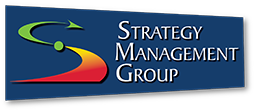
Strategic Thinking vs. Strategic Planning?
Recently a client asked a very simple, and yet extremely complex, question: “What’s the difference between ‘strategic thinking’ and ‘strategic planning’?” Great question! A quick Google search reveals that academics have pondered and debated this question since the early 1990’s. One extremely helpful scholarly overview can be found in the June 1998 volume 31 of Long Range Planning, in a very high-level discussion by Loizos Heracleous entitled “Strategic Thinking or Strategic Planning?” Heracleous presents a variety of perspectives from business academicians differentiating between the two.
While these scholarly discussions are intellectually stimulating, we are left lacking a simple and practical explanation to differentiate between the two. At the Strategy Management Group, we suggest that “strategic planning/management” and “strategic thinking” exist in a symbiotic relationship. The two not only work together…but they require each other. Strategic planning without strategic thinking will digress into a sluggish and lifeless process of setting goals and measuring objectives. Strategic thinking without strategic planning/management will cannibalize itself in a quest for structure and process. Strategic thinking informs strategic planning/management. Strategic planning/management gives voice, action and structure to strategic thinking.
In working with our clients, we find that most have a relatively strong understanding and appreciation for the value of strategic planning/management. Likewise, we find that many are hungering for an organizational culture which is bettered trained and more engaged in thinking strategically. So in our attempt to remain practical and engaged in the “real world” of our clients’ business, we underscore that at its essence, “Strategic Thinking” is a way of viewing challenges and opportunities from a variety of perspectives and altitudes, in order to proffer the very best solutions and directions. It is the habit of visualizing alternative futures for the organization and their impact on others. It’s not just a way of thinking what could be, but also a way of seeing what should be.
That said, training and cultivating an organizational culture to think strategically is a vital tool throughout the strategic planning process. During the high-level strategy formation phase, leaders thinking strategically will drive alignment around analyzing the opportunities from the widest possible perspective and understanding. During the operational and implementation phase, a strategic thinking organization will ensure that the higher level strategic direction cascades throughout the day-to-day decision making at all levels. C-suite executives, middle managers, and front line staff are entrusted with the freedom to think through solutions and trade-offs, to ensure each decision is best aligned with the overall strategic direction. Finally, during the all-important evaluation and control phase, strategic thinking ensures that an organization is measuring those drivers which best lead to success of the overall mission.
Strategic thinking is more than just “thinking outside the box” . . . it is also knowing which box to think outside of!

Broken Linkages: Are you SURE you are Executing Strategy?
I recently had a conversation with an organization’s board member who said, “I’m so frustrated. We have a balanced scorecard but I don’t see how the things the management team is measuring or executing are linked to our strategy. I don’t see the connections. Our balanced scorecard feels operational.” He was correct. Even with my practiced eye, I, too struggled to see clear linkages to strategy. Then I fielded a confidential call from the management team at the same organization who expressed their own frustration that their board members “just didn’t get it.” And as these conversations cycled, the board members became even more exasperated that there was no evidence that the organization was actually executing its strategy.

So, what’s the diagnosis? In two words: Broken Linkages.
While there are multiple approaches to developing a balanced scorecard, most balanced scorecard practitioners will agree that balanced scorecards connect strategic planning with strategy execution.
But too often, the critical linkages between strategy and execution are broken.
Why? A primary cause for broken linkages is when one team creates the organization’s
strategic plan (a Board or an executive team) and then a different team (a management team or task force) is expected to “convert” the strategic plan to a balanced scorecard. This piecemeal, “throw it over the fence,” approach to scorecard-building has three fatal flaw
- The strategy itself is usually incompatible for use with a balanced scorecard. Typical strategic planning frameworks rarely contain clear and purposeful linkages all the way from high level vision, mission, and competitive positioning down through focus areas (strategic themes) and strategic objectives (which are the critical linkages used by balanced scorecard to connect strategy with execution).
- The strategy is usually incomplete. More likely than not, there was no consideration during strategy formulation of the four interdependent dimensions of strategic drivers and results (e.g. balanced scorecard perspectives) which usually results in a focus on results with no consideration of key drivers. Key drivers are critical strategic choices and the crux of ensuring an executable strategy.
- The strategy gets lost in translation. The balanced scorecard team and/or their consultant find themselves sifting through a strategy document to try and extrapolate what the driver and result objectives should be, what perspectives they belong in, and if/how the objectives are interrelated. These are the basic building blocks for a balanced scorecard. This approach can lead to erroneous assumptions about strategy, or even worse, the team may just abandon the effort to interpret the strategy and, instead, fall back on obvious operational objectives needed to ensure that the organization functions exactly as it always has. The resultant operational objectives may or may not be aligned with the organization’s desired FUTURE – its desired strategic direction or its shift in competitive positioning.
In other words, they end up with a scorecard similar to the one the board member was complaining about…one that simply measures normal operational execution and has no connection to strategy.
If your linkages are broken, contact us about a strategic health assessment. Your current strategic planning & management materials and process will be assessed and compared to best practice and a gap assessment will be delivered to show you where the linkages are broken and what needs to be done to repair them.

The Ultimate KPI Cheat Sheet
We’ve received a lot of interest in our new KPI Certification Program. In fact, one woman said she couldn’t wait until the first scheduled program offering. She also wanted to know if we had a handy list of the most important principles – she wanted a cheat sheet! So in the interest in tiding her (and others) over, below I have compiled a few of the most important KPI tips and tricks. There are many more of course, so if you think I’ve missed anything, please add them in the comments section below.
Strategy comes first!
A training student told me his organization is struggling to implement measures for brand equity, customer engagement, and a few others because they believed the measures didn’t really apply to their company. I asked him why they were implementing those measures if they didn’t seem to apply, and he said they had found them in a book. They had no strategy or goals of any sort, and yet somehow thought they had a measurement problem.
KPIs found in a book of measures don’t necessarily mean anything in relation to your strategy. If you don’t have a strategy and/or can’t articulate what you are trying to accomplish, it is too early for KPIs.
KPI Development is a Process
I am embarrassed to admit that the first time I facilitated the development of performance measures with a client, I stood in front of a blank flip chart and asked them to brainstorm potential measures. It was my first consulting engagement as a junior associate and the project lead had stepped out to take an emergency phone call. Even though I had a basic understanding of what good KPIs looked like, I couldn’t help the client come up with anything other than project milestones (“complete the web redesign by August”), improvement initiatives (“we need to redesign the CRM Process”), or vague ideals (“customer loyalty”). What I didn’t understand at the time is that you need to use a deliberate process for developing KPIs, based on the intended results within your strategy. And like any other process, KPI development requires continuous improvement discipline and focus to get better.
Articulate Intended Results Using Concrete, Sensory-Specific Language
Strategy teams have a habit of writing strategy in vague, abstract ideals. As you pivot from strategy to measurement, it is critical that you articulate what this strategy actually looks like using concrete language that you could see, hear, taste, touch or smell. A vaguely written strategic objective like Improve the Customer Experience might get translated into checkout is fast, or facilities are safe and clean. Improve Association Member Engagement might get translated into a result of members volunteer for extracurricular activities. I’ve seen strategy teams shift from 100% agreement on vague ideals to diametric opposition on potential intended results, indicating that their consensus around strategy was actually an illusion. Use simple language a fifth-grader could understand to describe the result you are seeking. If you spend your time honing this intended result, the most useful performance measures almost jumps out at you.
It’s not about the Dashboard!
Dashboard software is great when it is used to support a well-designed strategic management system. Unfortunately, many people are more interested in buying a flashy new tool than they are in understanding how they are performing (a topic I’ve talked about before). KPIs are not about a dashboard. KPIs are about articulating what you are trying to accomplish and then monitoring your progress towards those goals. A dashboard is the supporting tool and too much emphasis on technology misses and often distracts us from the point.
It’s not about the KPIs!
Speaking of people missing the point, we have many clients who think this process begins and ends with the KPIs themselves. Unfortunately, some of these folks are simply trying to meet a reporting requirement or prepare for a single important meeting. This type of approach completely misses the power of KPI development, which is that KPIs provide evidence to inform strategic decisions and enable continuous improvement.
For more about how to improve KPI development in your organization, see our KPI Professional Certification Program or The Institute Way: Simplify Strategic Planning and Management with the Balanced Scorecard.

CEO Epic Fail: Have a Blueprint BEFORE You Swing the Hammer
Have you ever noticed how a newly hired CEO often starts his/her tenure with a BANG! Making all sorts of immediate changes – whether it’s replacing the entire leadership team, reorganizing, initiating a major acquisition or spinning off a business unit? One thing that is a hallmark of new CEOs is…change! And this creates great tension and, often chaos, within the organization. Yet many of these CEOs, after 3-5 years, quietly disappear…leaving the organization different, but not necessarily better, than they found it.

I used to puzzle over this as I observed it over and over – at companies, at school districts, at large non-profits. Why would someone create such chaos and stress, and then just leave? That’s unconscionable!
Over time, I’ve come to understand that they aren’t evil and they don’t do it on purpose. Most of these CEOs arrive on the job with the best of intentions. And they didn’t intend to create a mess and leave.
But they feel a lot of pressure to show immediate results. So they often rely upon an action they’ve successfully used elsewhere to try and effect immediate change – whether their favorite go-to action is reorganization, an acquisition, or draconian cost-cutting. They immediately implement this action and the staff straps themselves into their office chairs and braces for impact of sudden, and sometimes violent, change.
In laymen’s terms: When you have is a hammer, everything looks like a nail.
And yes, sometimes the action does produce short-term results. But then what? Often the CEO seems to fizzle out – they don’t have any more big ideas and can’t seem to make any more progress in improving organizational results. Or maybe the action they chose didn’t even produce the desired effect, at all. Either way, they slowly disengage and…leave. The staff cheer. And then brace for impact of the next CEO. It’s a dreadful cycle.
Yet there is hope. There are CEOs who do achieve tremendous long-term results and who command the greatest respect (and devotion) from their employees, year over year. I believe one of the secrets is that these CEOs don’t immediately reach for their “go-to hammer”. In fact, they don’t actually believe they have all the answers. And they rarely give orders for immediate high-impact action upon arrival (unless, of course, the organization is a breath away from failure when they hire on).
These truly fearless leaders enable and empower their staff to be part of their TEAM. They are able to articulate their long-term goals for the organization and lay out a blueprint. And they LEAD the organization in such a way that staff is eager to help achieve the organization’s long-term goals. Sure, sometimes this requires some difficult or stressful actions – reorganization, replacing leadership team members, draconian cost-cutting, spin-offs and acquisitions. But the difference is that these successful CEOs do a fantastic job of communicating the big picture and of including staff in the conversations (and sometimes in the decisions) about the future of the organization. So, when the tough decisions ARE made – people understand and feel respected.
We’ve been privileged to watch some really successful CEOs achieve results and earn the respect and loyalty of their staff – by using a strategic blueprint.

Visionary Leaders: What’s Their Secret?
An executive once asked me a question that launched me on a 4-year quest for an answer. We were discussing examples of visionary leaders who led their organizations to great heights. He looked at me with desperation in his eyes and said, “HOW do visionary leaders think of this stuff? I’m not Steve Jobs or Henry Ford. I have no brilliant ideas.” 
My only response, at the time, was “I don’t know…our process just works” and to give him some real client examples. But it bugged me that I couldn’t explain exactly HOW it works.
As an engineer, I am driven to understand how things work…and thus began the 4 year quest. I started paying attention to when and how that “flash of visionary inspiration” happens when we work with consulting clients.
And my quest to understand HOW the process works led me to a variety of studies in strategy, innovation, neuroscience, leadership, psychology, business history, and military history. Along the way, I discovered that there are actually TWO definitions of “strategy”1. But most of us, are only familiar with one! Did you know that? I was stunned.
In the 1830’s, the definition of strategy “lost” a key component when two strategy books were written based on the successes of Napoleon. The first was written by a German, Clausewitz, and this dense, hard-to-read tome carried forward the full definition of strategy from the earliest thinkers on the topic of strategy, from Sun Tzu forward. The second book, written in French by Jomini, was much easier for readers to understand. But Jomini’s book left out a portion of what Clausewitz and all prior writers had included in their definition of strategy.
Fast forward from 1830 and you’ll see that military strategists relied upon Jomini’s writings…and business strategy concepts evolved from military strategy. Consequently, the definition of strategy that most of us are familiar with is actually only a PARTIAL definition. Today, we define strategy as “how to get from Point A to Point B.”
The missing component of strategy, which was dropped by Jomini in the 1830’s, is: How to determine the strategically unique “Point B” in the first place – not just choosing an obvious “Point B” that others in your industry are likely to choose. This strategic inspiration is what we associate with visionary leaders.
I know that the Institute’s strategic planning process is unique because we (admittedly unknowingly) have always incorporated the FULL definition of strategy – our clients regularly have strategic insights regarding “Point B” and then we develop a strategy to get from Point A to Point B. But to understand HOW our process facilitates the mysterious “inspiration” part of strategic visioning, I had to study further.
Neuroscience and writers in the field of innovation tell us that creative ideas are nothing more than the brain combining bits of already known information in a new way. If you look at scientific discovery, the arts, history…you see this is true. In my study of innovation, I’ve yet to see an example of a truly original idea. In reality, ideas build upon pre-existing information and combine things in new ways.
By way of example: Steve Jobs had a spark of inspiration when he visited Xerox and they showed him their research into GUI (Graphical User Interface) and he imagined combining this with a desktop computer. Henry Ford had a spark of inspiration when he visited an animal processing plant and imagined reversing the “animal disassembly line” and, instead, creating a moving assembly line to build an automobile.
I’ve been privy to watch flashes of inspiration happen when a client combines things in a new way and realizes “there is our Point B!” So HOW, exactly, do we incubate strategic visioning? And that’s when I had my own “aha!” moment. To “incubate” means to ensure the right conditions exist for something to take form. And THAT’S the secret!
So what are these conditions? First, the brain needs to contain lots of information and ideas to have fodder for new combinations. The Institute’s proprietary strategic planning process stocks and stimulates the brain via the strategic thinking exercises we lead the client to perform, as well as via our use of diverse teams (which brings more information, facts, and ideas into the process). The more you have to work with, the more likely you are to find an innovative combination.
Second, one’s mind must relax. Ever notice how your best ideas come when your mind is calm? In the shower? While jogging? While you are half asleep? That’s when your brain is free to combine things in new and innovative ways. Our workshops are conducted in stress-free locations. And we simply lead the team, step by step, through various strategic thinking and decision-making exercises in a relaxed environment. There is no pressure or expectations for the leadership team to come up with something brilliant. We simply work through our proven process.
So, the answer that I have come to, after four long years, is that you need to create the right conditions to be “visionary”. A leader can prepare him/herself by constantly learning. Read. Study. Attend seminars. Network. Get out and visit other companies. Steve Jobs visited Xerox. Henry Ford visited the animal processing plant. Both had numerous outside interests. The more you learn and experience, the more information you will have in your head. Then, relax. Free your mind and let inspiration find YOU.
Furthermore, I came to realize that a good leader doesn’t have to have all the answers. The Institute’s inclusive process actually takes the burden off of the leader and leverages the innovation potential throughout the organization. When all staff understand the big picture, this information gets combined with everything the staff knows and has experienced….and creative ideas spark! At one client, the factory union steward is the individual who actually had the eureka moment regarding the future of the company.
If you want us to lead your team through the process of finding your strategically unique “Point B”, contact us about our strategic consulting services.
1In the spirit of continuous learning, I also highly recommend one of the sources that helped provide the final missing link in my study on this topic: William Duggan’s book, Strategic Intuition: The Creative Spark in Human Achievement.

